
Algae are any of a large and diverse group of photosynthetic, eukaryotic organisms. The name is an informal term for a polyphyletic grouping that includes species from multiple distinct clades. Included organisms range from unicellular microalgae, such as Chlorella, Prototheca and the diatoms, to multicellular forms, such as the giant kelp, a large brown alga which may grow up to 50 metres (160 ft) in length. Most are aquatic and lack many of the distinct cell and tissue types, such as stomata, xylem and phloem that are found in land plants. The largest and most complex marine algae are called seaweeds, while the most complex freshwater forms are the Charophyta, a division of green algae which includes, for example, Spirogyra and stoneworts. Algae that are carried by water are plankton, specifically phytoplankton.

Spirulina is a biomass of cyanobacteria that can be consumed by humans and animals. The three species are Arthrospira platensis, A. fusiformis, and A. maxima.

Midreshet Ben-Gurion, also known as Midreshet Sde Boker, is an educational center and boarding school in southern Israel. Located in the Negev next to kibbutz Sde Boker, it falls under the jurisdiction of Ramat HaNegev Regional Council. In 2022 it had a population of 1,938.

Astaxanthin is a keto-carotenoid within a group of chemical compounds known as terpenes. Astaxanthin is a metabolite of zeaxanthin and canthaxanthin, containing both hydroxyl and ketone functional groups. It is a lipid-soluble pigment with red coloring properties, which result from the extended chain of conjugated double bonds at the center of the compound. The presence of the hydroxyl functional groups and the hydrophobic hydrocarbons render the molecule amphiphilic.

Canthaxanthin is a keto-carotenoid pigment widely distributed in nature. Carotenoids belong to a larger class of phytochemicals known as terpenoids. The chemical formula of canthaxanthin is C40H52O2. It was first isolated in edible mushrooms. It has also been found in green algae, bacteria, crustaceans, and bioaccumulates in fish such as carp, golden grey mullet, seabream and trush wrasse.

Azotobacter is a genus of usually motile, oval or spherical bacteria that form thick-walled cysts and may produce large quantities of capsular slime. They are aerobic, free-living soil microbes that play an important role in the nitrogen cycle in nature, binding atmospheric nitrogen, which is inaccessible to plants, and releasing it in the form of ammonium ions into the soil. In addition to being a model organism for studying diazotrophs, it is used by humans for the production of biofertilizers, food additives, and some biopolymers. The first representative of the genus, Azotobacter chroococcum, was discovered and described in 1901 by Dutch microbiologist and botanist Martinus Beijerinck. Azotobacter species are Gram-negative bacteria found in neutral and alkaline soils, in water, and in association with some plants.
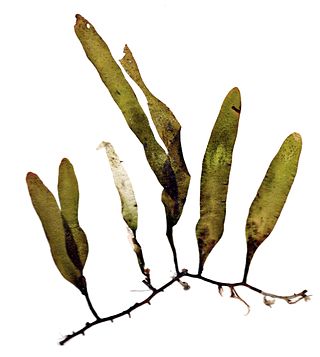
Caulerpa is a genus of seaweeds in the family Caulerpaceae. They are unusual because they consist of only one cell with many nuclei, making them among the biggest single cells in the world.

Ketura is a kibbutz in southern Israel. Located north of Eilat in the Aravah Valley, it falls under the jurisdiction of Hevel Eilot Regional Council. In 2022 it had a population of 509.
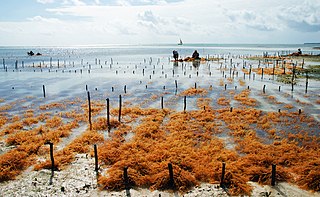
Algaculture is a form of aquaculture involving the farming of species of algae.
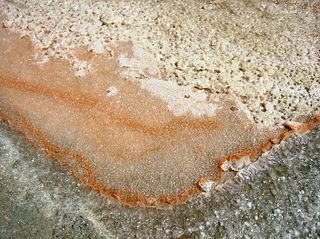
Dunaliella salina is a type of halophile unicellular green algae especially found in hypersaline environments, such as salt lakes and salt evaporation ponds. Known for its antioxidant activity because of its ability to create a large amount of carotenoids, it is responsible for most of the primary production in hypersaline environments worldwide, and is also used in cosmetics and dietary supplements.

Chlamydomonas nivalis, also referred to as Chloromonas typhlos, is a unicellular red-coloured photosynthetic green alga that is found in the snowfields of the alps and polar regions all over the world. They are one of the main algae responsible for causing the phenomenon of watermelon snow, where patches of snow appear red or pink. The first account of microbial communities that form red snow was made by Aristotle. Researchers have been active in studying this organism for over 100 years.

A photobioreactor (PBR) refers to any cultivation system designed for growing photoautotrophic organisms using artificial light sources or solar light to facilitate photosynthesis. Photobioreactors are typically used to cultivate microalgae, cyanobacteria, and some mosses. Photobioreactors can be open systems, such as raceway ponds, which rely upon natural sources of light and carbon dioxide. Closed photobioreactors are flexible systems that can be controlled to the physiological requirements of the cultured organism, resulting in optimal growth rates and purity levels. Photobioreactors are typically used for the cultivation of bioactive compounds for biofuels, pharmaceuticals, and other industrial uses.

Vinasse is a byproduct of the sugar or ethanol industry. Sugarcane or sugar beet is processed to produce crystalline sugar, pulp and molasses. The latter are further processed by fermentation to ethanol, ascorbic acid or other products. Juice sugarcane can also be processed directly by ethanol fermentation. After the removal of the desired product the remaining material is called vinasse. Vinasse is sold after a partial dehydration and usually has a viscosity comparable to molasses. Commercially offered vinasse comes either from sugar cane and is called cane-vinasse or from sugar beet and is called beet-vinasse. Vinasse produced from sugar cane is also called dunder.
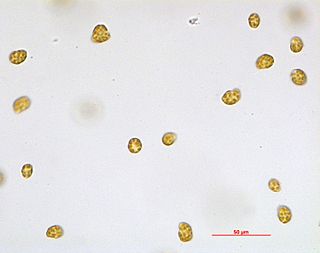
Heterosigma akashiwo is a species of microscopic algae of the class Raphidophyceae. It is a swimming marine alga that episodically forms toxic surface aggregations known as harmful algal bloom. The species name akashiwo is from the Japanese for "red tide".

Dunaliella is a single-celled, photosynthetic green alga, that is characteristic for its ability to outcompete other organisms and thrive in hypersaline environments. It is mostly a marine organism, though there are a few freshwater species that tend to be more rare. It is a genus in which certain species can accumulate relatively large amounts of β-carotenoids and glycerol in very harsh growth conditions consisting of high light intensities, high salt concentrations, and limited oxygen and nitrogen levels, yet is still very abundant in lakes and lagoons all around the world.
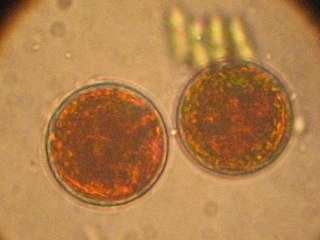
Haematococcus is a genus of algae in the family Haematococcaceae. Members of this group are a common cause of the pink color found in birdbaths. One of the most notable species of Haematococcus is H. pluvialis, which is used in cosmetic products due to its production of astaxanthin, a powerful antioxidant carotenoid, under stress conditions.

Nannochloropsis is a genus of algae comprising six known species. The genus in the current taxonomic classification was first termed by Hibberd (1981). The species have mostly been known from the marine environment but also occur in fresh and brackish water. All of the species are small, nonmotile spheres which do not express any distinct morphological features that can be distinguished by either light or electron microscopy. The characterisation is mostly done by rbcL gene and 18S rRNA sequence analysis.

Microalgae or microscopic algae grow in either marine or freshwater systems. They are primary producers in the oceans that convert water and carbon dioxide to biomass and oxygen in the presence of sunlight.
Sammy Boussiba is a professor emeritus at the French Associates Institute for Agriculture and Biotechnology of Drylands at the Jacob Blaustein Institutes for Desert Research at Ben-Gurion University of the Negev, Israel.

Vampyrella lateritia is a freshwater species of predatory amoebae that feeds on species of algae and is known for its specialized feeding strategy of removing, digesting, and ingesting the cellular contents of its prey. It is the type species of the genus Vampyrella and has been identified in numerous locations around the world including Brazil, Germany, and the eastern United States. Along with Vampyrella pendula, its genome was sequenced in 2012.























